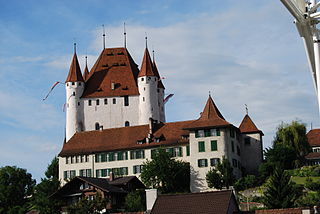Related Research Articles

Bern, or Berne, is the de facto capital of Switzerland, referred to as the "federal city". With a population of about 133,000, Bern is the fifth-most populous city in Switzerland, behind Zürich, Geneva, Basel and Lausanne. The Bern agglomeration, which includes 36 municipalities, had a population of 406,900 in 2014. The metropolitan area had a population of 660,000 in 2000.

The canton of Bern, or Berne, is one of the 26 cantons forming the Swiss Confederation. Its capital city, Bern, is also the de facto capital of Switzerland. The bear is the heraldic symbol of the canton, displayed on a red-yellow background.

Several illustrated chronicles were created in the Old Swiss Confederacy in the 15th and 16th centuries. They were luxurious illuminated manuscripts produced for the urban elite of Bern and Lucerne, and their copious detailed illustrations allow a unique insight into the politics and daily life of late medieval Switzerland on the eve of the Reformation. The most important of these chronicles are the works of the two Diebold Schillings, their luxurious execution, as well as their content reflecting the growing confidence and self-esteem of the leaders of the confederacy after their spectacular successes in the Burgundian Wars.

Valerius Anshelm, born as Valerius Rüd, was a Swiss chronicler working in Bern.

The Battle of Laupen was fought in June 1339, between Bern and its allies on one side, and Freiburg together with feudal landholders from the County of Burgundy and Habsburg territories on the other. Bern was victorious, consolidating its position in the region. As a consequence of the conflict, the relations of Bern and the Swiss Confederacy tightened, resulting in Bern's permanent accession in 1353.

The city of Bern is one of the Zähringer foundations of the late 12th century. By the end of the 13th century, it had acquired de facto imperial immediacy. It became a full member of the Old Swiss Confederacy in 1353, and during the 15th century managed to significantly expand its sphere of influence, notably with the conquest of Aargau in 1415. With the acquisition of Vaud in 1536, Bern became the most powerful city-republic north of the Alps, and one of the leading Protestant cities in early modern Switzerland. The canton of Bern in the Restored Confederacy of 1815 even after the loss of Aargau and Vaud remained the largest Swiss canton, relegated to second rank only with the secession of Jura in 1979. Since 1848 Bern has served as the federal city (capital) of Switzerland.

The coat of arms of Bern, along with the associated flag and heraldic colours, are used both by the Swiss city of Bern and by the canton of the same name. They were also used by the former district of Bern until its abolition in 2009.

Laupen is a municipality in the Bern-Mittelland administrative district and its district capital, situated in the canton of Bern in Switzerland.

Hans Gieng was a Swiss Renaissance sculptor best known for his public fountain figures in the Old Town of Bern as well as Fribourg.
The Chronicle of the City of Lucerne is the oldest existing chronological account of the history of the city of Lucerne.

The Chronicle of the Swiss Confederation is the oldest printed chronicle of Switzerland. The Chronicle of the Swiss Confederation was written by Petermann Etterlin’s from Lucerne. According to the Swiss historian Jean-François Bergier, Etterlin decided to compose a chronicle on the history of the city of Lucerne towards the end of his life, between 1505 and 1507. Etterlin’s chronicle, which was printed for the first time in 1507 by Michael Furter, is considered to be the earliest surviving printed version of the William Tell story.
Conrad Justinger was a 14th-century chronicler who was probably born in Strasbourg.

Berner Haselnusslebkuchen are traditional Christmas cakes (Lebkuchen) from Bern, Switzerland. Made from ground hazelnuts, they are not to be confused with the Berner Honiglebkuchen, another Bernese specialty.

Berner Honiglebkuchen are Lebkuchen traditionally made in Bern, Switzerland. Distinguished from other Lebkuchen by their sometimes elaborate sugar decorations, they are not to be confused with the Berner Haselnusslebkuchen, another Bernese specialty which is made from ground hazelnuts.

The carnival in Bern, Switzerland is an annual pre-Lenten festival in the Swabian-Alemannic tradition.

Rudolf von Erlach was a knight and commander of the Swiss Confederation forces at the Battle of Laupen.

The Erlach family was a Bernese patrician family. They first became citizens of Bern around 1300. During the 17th and 18th centuries they were one of the leading families in Bern. For centuries the family served as senior military commanders in both Bern and in foreign armies. They were mayors of Bern and ruled over many other towns and cities in western Switzerland. Several family members received the upper nobility title "Reichsgraf".

Thun Castle is a castle in the city of Thun, in the Swiss canton of Bern. It was built in the 12th century, today houses the Thun Castle museum, and is a Swiss heritage site of national significance.
The following is a timeline of the history of the municipality of Bern, Switzerland.

John Burnaby (1701–1774) was a British diplomat. He was Resident minister to the Swiss cantons.
References
- 1 2 3 Zahnd, Urs M. “Erläuterungen.” 12 April 2008. "Berner Chronik des Conrad Justinger". Archived from the original on 2008-06-06. Retrieved 2008-05-01.
- 1 2 3 Müller, P. L. “Konrad Justinger.” Allgemeine Deutsche Biographie 14 (1881): 758–759.